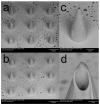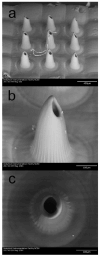Multiphoton microscopy of transdermal quantum dot delivery using two photon polymerization-fabricated polymer microneedles
- PMID: 21413181
- PMCID: PMC3060378
- DOI: 10.1039/c005374k
Multiphoton microscopy of transdermal quantum dot delivery using two photon polymerization-fabricated polymer microneedles
Abstract
Due to their ability to serve as fluorophores and drug delivery vehicles, quantum dots are a powerful tool for theranostics-based clinical applications. In this study, microneedle devices for transdermal drug delivery were fabricated by means of two-photon polymerization of an acrylate-based polymer. We examined proliferation of cells on this polymer using neonatal human epidermal keratinocytes and human dermal fibroblasts. The microneedle device was used to inject quantum dots into porcine skin; imaging of the quantum dots was performed using multiphoton microscopy.
Figures








Similar articles
-
Fabrication of microneedles using two photon polymerization for transdermal delivery of nanomaterials.J Nanosci Nanotechnol. 2010 Oct;10(10):6305-12. doi: 10.1166/jnn.2010.2636. J Nanosci Nanotechnol. 2010. PMID: 21137723
-
Tapered conical polymer microneedles fabricated using an integrated lens technique for transdermal drug delivery.IEEE Trans Biomed Eng. 2007 May;54(5):903-13. doi: 10.1109/TBME.2006.889173. IEEE Trans Biomed Eng. 2007. PMID: 17518288
-
Ex vivo evaluation of a microneedle array device for transdermal application.Int J Pharm. 2015 Dec 30;496(2):351-9. doi: 10.1016/j.ijpharm.2015.09.070. Epub 2015 Oct 21. Int J Pharm. 2015. PMID: 26453791
-
A key role by polymers in microneedle technology: a new era.Drug Dev Ind Pharm. 2021 Nov;47(11):1713-1732. doi: 10.1080/03639045.2022.2058531. Epub 2022 Apr 6. Drug Dev Ind Pharm. 2021. PMID: 35332822 Review.
-
Current trends in polymer microneedle for transdermal drug delivery.Int J Pharm. 2020 Sep 25;587:119673. doi: 10.1016/j.ijpharm.2020.119673. Epub 2020 Jul 30. Int J Pharm. 2020. PMID: 32739388 Free PMC article. Review.
Cited by
-
Progress in Microneedle-Mediated Protein Delivery.J Clin Med. 2020 Feb 17;9(2):542. doi: 10.3390/jcm9020542. J Clin Med. 2020. PMID: 32079212 Free PMC article. Review.
-
Two-Photon Polymerisation 3D Printing of Microneedle Array Templates with Versatile Designs: Application in the Development of Polymeric Drug Delivery Systems.Pharm Res. 2020 Aug 27;37(9):174. doi: 10.1007/s11095-020-02887-9. Pharm Res. 2020. PMID: 32856172 Free PMC article.
-
Digital Manufacturing for Microfluidics.Annu Rev Biomed Eng. 2019 Jun 4;21:325-364. doi: 10.1146/annurev-bioeng-092618-020341. Annu Rev Biomed Eng. 2019. PMID: 31167099 Free PMC article. Review.
-
Revolutionizing Therapeutic Delivery with Microneedle Technology for Tumor Treatment.Pharmaceutics. 2022 Dec 21;15(1):14. doi: 10.3390/pharmaceutics15010014. Pharmaceutics. 2022. PMID: 36678643 Free PMC article. Review.
-
The Effects of Geometry on Skin Penetration and Failure of Polymer Microneedles.J Adhes Sci Technol. 2013 Feb 1;27(3):227-243. doi: 10.1080/01694243.2012.705101. Epub 2012 Aug 6. J Adhes Sci Technol. 2013. PMID: 23543070 Free PMC article.
References
-
- Warner S. Scientist. 2004;18:38–39.
MeSH terms
Substances
Grants and funding
LinkOut - more resources
Full Text Sources
Other Literature Sources

